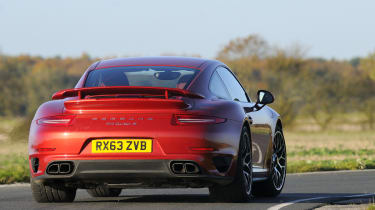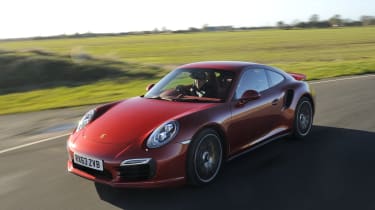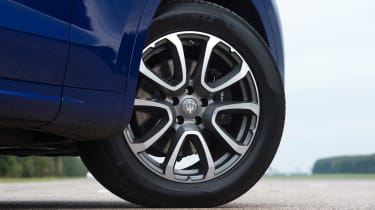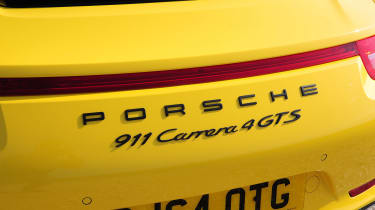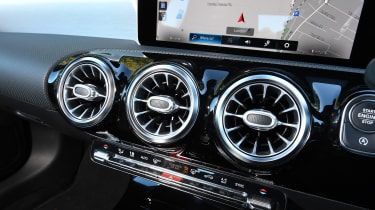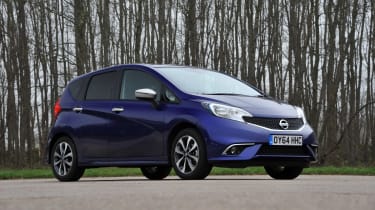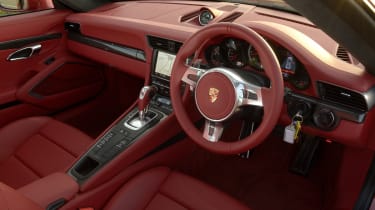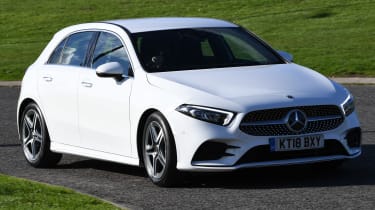Porsche 911 991 (2012-2015) review
The long-running Porsche 911 sports car is faster and more comfortable than ever

No other sports car can match the over half a century heritage of the Porsche 911. The rear-engined layout has hardly changed since the car was launched in 1963, but the latest car can rightly claim to be the most technically accomplished in its class.
Over the past half-century, the rear-engined Porsche has evolved into one of the most complete and thrilling sports cars money can buy. The latest model was launched in 2011, and is faster and more composed than ever, yet it also boasts impressive efficiency and surprising practicality.
• Porsche 911 vs Mercedes-AMG GT
Its powerful engine range and better chassis means it’s also faster and safer, too. Greater use of aluminium means the car is now lighter, while the new seven-speed manual gearbox is a world first. The 345bhp Carrera, 395bhp Carrera S, and 424bhp GTS in two and four-wheel drive, and Coupe and Cabriolet bodystyles are the mainstays of the range, but the 469bhp GT3 is the most focused offering, though it's now all sold out in the UK, while the Turbo and Turbo S are the range toppers. There's a retro-inspired Targa model, which sits somewhere between the Coupe and the Cabriolet, too.
Used - available now
Porsche has a long history of building race-bred 911s for the road. And one of the most established models in this thoroughbred stable is the GT3, which first appeared on our roads in 1999. Unlike its stripped-out predecessors, this new one is packed with hi-tech additions, including four-wheel steering, a heavily revised PDK twin-clutch gearbox and an all-new, direct-injection flat-six engine.
Engines, performance and drive
If you’re looking for driving thrills above all else, the 911 is still hard to beat. Decades of development have turned the once wayward rear-engined Porsche into one of the most poised and agile machines ever.
At the core of this is the new engine range. The biggest seller is the entry-level 345bhp 3.4-litre Carrera. Step up to the Carrera S and you get a 3.8-litre with 395bhp that delivers a staggering blend of power and response. That engine is reworked slightly and produces 424bhp in the GTS giving the car a even more frenetic top end rush. And when fitted with the optional PDK paddle shift gearbox that car can get from 0-60mph in just 3.8 seconds.
However, the 911's advanced chassis control systems also deserve special mention as they give the car incredible mid-corner stability.
A change to the 911’s steering set up means the car is much more comfortable on motorways. It's extremely refined, too - when cruising in seventh gear on a smooth surface, you can almost hear the ticking of the dash-mounted stopwatch that's offered as part of the Sport Chrono package. The Sport Chrono pack is optional on the Carrera and S models but standard on the GTS, which also comes with active engine mounts, sportier settings for the active suspension and a sports exhaust.
The manual gearbox did feel a little clunky at low-speed though Porsche has recently updated it by giving it a slightly smoother shift. Despite this, we would still opt for the fast and precise PDK automatic as its quicker than the manual and more relaxing too. The four-wheel drive models do command a hefty premium, so we'd only recommend them if you really need their excellent all-weather ability.
The 911 Turbo S is a car that requires you to reboot your expectations of grip and acceleration. With variable-vane twin turbos and direct injection, the 3.8-litre flat-six engine produces 552bhp (36bhp up on the Turbo) and 700Nm of torque. Helped by launch control, it rockets from 0-60mph in just 2.8 seconds, but on the road it’s the staggering in-gear response that blows you away.
There’s a seemingly never-ending reserve of thrust on tap, regardless of your speed or revs. Few cars we’ve tested are as fast as the Turbo S, yet it doesn’t feel intimidating at all. In fact, you’ll need plenty of self control, especially since the engine sounds so good at the higher reaches of its rev range. In addition to more power, the S comes with ceramic brakes, Porsche Dynamic Chassis Control (PDCC), active roll bars and the Sport Chrono Pack Plus, which includes dynamic engine mounts. Plus, as with the standard Turbo, it has active rear steering, PASM adaptive damping and active aerodynamics.
In short, the Turbo S features every piece of performance technology that Porsche offers on the 911. And it shows.
Traction is amazing, thanks to the four-wheel drive and torque vectoring, while the active roll bars all but eliminate body roll. The active rear axle helps low-speed agility and stability at higher speeds, while the steering is fast and communicative.
The Turbo responds instantly and remains incredibly poised, planted and untroubled by even the most challenging of roads. Astonishing grip levels mean you’ll never get close to reaching this car’s limits on the road. Head to the test track, however, and put the dampers, throttle and PDK into their sportiest settings, and you’ll discover a whole new layer of ability.
Here, the razor-sharp turn-in, incredible high-speed stability and immense stopping power of the Turbo S really shine through. With PDCC, the near-absence of body roll takes some getting used to, but the 911 never feels artificial or inert. However, when the rear tyres finally lose grip you’ll need quick reactions, as all the inertia stored up by the PDCC releases to add weight to the slide.
Yet for all its on-the-limit prowess, the Turbo S is marked out by the fact it’s just as easy to live with as any other 911. The PDK gearbox is great and there’s none of the drivetrain shunt you find in the Nissan GT-R for example.
With PASM dampers the ride is decent, too, although the tyres generate a fair bit of roar. But for ultimate thrills the track-focused chassis, racy engine and optimised PDK of the GT3 take some beating.
The GT3 model's electrically assisted steering is quick and full of feel, there’s barely any body roll and, in the dry, virtually limitless grip. Better still, the optional ceramic brakes provide eye-popping stopping power.
The least sharp 911 has to be the Targa; it's 110kg heavier than a similar coupé and 40kg heavier than a 911 Cabriolet. Engineers have also set it up to be a little more comfortable than every other 911 so it feels a little bit softer in the bends, too.
The 911 that gives the best blend of performance, handling and value is the GTS - especially in Carrera 2 guise. It's sharper to drive and faster than the S, and gets close to the thrills of the GT3 - but it's still a well-rounded road car. Plus, the extra kit is well worth the comparatively moderate price hike.
For those who want wind in the hair thrills there is either the Cabriolet or Targa to choose from. The latter is not available as a Turbo and comes with all-wheel drive only. Both share the same underpinnings and are heavier than their coupe counterparts by up to 85kg due to extra bracing to counteract the loss in rigidity by chopping off the roof.
The Targa is the heaviest model and although its roll over hoop does add some extra structural rigidity over the Cabriolet, it does have slightly softer suspension settings. Overall, the 911 Coupes are the sharper drive but the drop-top models have been engineered so well that they deliver all the grip and handling you could ever exploit safely on the road.
Having said all that, the 911 which gives the best blend of performance, handling and value if the GTS - especially in Carrera 2 guise. It's shaper to drive and faster than the S on which its based and gets close to the thrills of the GT3 yet is a more rounded road car. Also, the added value of the extra kit is well worth the comparatively moderate price hike.
MPG, CO2 and Running Costs
If you’re in the market for a a sports car like this, then running costs are not going to be a priority. Even so Both Carrera and Carrera S versions of the new Porsche 911 offer fuel economy of more than 30mpg and even the 911 Turbo is a more affordable option than some exotic rivals. Standard stop-start helps economy and lowers emissions to 227g/km on both the Turbo and Turbo S, while we averaged a very impressive 26.3mpg on a mixed urban and motorway run.
Servicing is expensive, The hi-tech 911 uses lots of high quality parts and consumables like tyres and brake pads, so it's likely the 911 will prove expensive to maintain. You can expect routine maintenance costs of around £1,000 per scheduled service. However, unlike most other manufacturers Porsche requires you to get your 911 serviced only every two years. Group 50 insurance means big premiums. Our experts have calculated that the standard Carrera will retain more than 50 per cent of its value over three years.
Interior, design and technology
With its round headlamps, arcing roof line and compact proportions, the basic shape of the Porsche 911 is familiar, but it has gone through a steady process of evolution and the latest 991 generation looks bang up to date. This time around, the most significant alterations include a 100mm longer wheelbase, a wider front track, larger 19-inch wheels, and a 20mm lower roof line. The windscreen is more steeply raked, the fog lamps are integrated into the front bumper and the rear lights are slimmer.
There’s no mistaking the GT3 for any other model in the 911 line-up. For starters, its bulging rear wheelarches are 44mm wider than a standard Carrera’s, while the huge spoiler on the engine cover helps generate downforce at high speeds.
Elsewhere you’ll spot the deeper front and rear bumpers, extra cooling vents cut into the bonnet and grille, and the eye-catching mirrors. Further clues to the car’s potential include the huge 20-inch forged aluminium wheels that hide the GT3’s massive, £6,248 optional carbon-ceramic disc brakes. Thanks to these changes, the Porsche looks every inch a racing car for the road – an impression that’s reinforced when you climb behind the wheel.
To fit wide tyres and forged 20-inch wheels, the rear wheelarches are 28mm wider than a Carrera 4’s, while the gaping air vents suck air into the mighty engine and the active rear wing rises in search of downforce. The Turbo S is also marked out by its full LED headlights. Yet for all this, park it next to the R8 and the Porsche still doesn’t look quite as glamorous.
All cars get 19-inch alloys, slim LED tail- lights and a powered rear spoiler that rises up to boost stability at speed, while Carrera S models are identified by their larger 20-inch rims and quad-exit exhausts.
There are nods to the past inside, such as the trademark five-dial layout that features a large, centrally mounted rev-counter. However, the rest of the cabin is up to date, with slick design, top-notch materials and impeccable build quality.
The low-slung driving position is supremely comfortable, visibility is excellent and the major controls are perfectly sited. Most of the robust-feeling switchgear is arranged along the wide transmission tunnel, while the standard touchscreen infotainment system is intuitive to use and features clear graphics.
A special 911 50 Edition was offered in late 2013 and early 2014, boasting a few retro touches from when the very first 911 was introduced in 1963. The Targa model takes a similar approach, boasting a silver roll-over hoop and wraparound rear windscreen just like the very first Targa.
Sitting between the S and the GT3 is the Porsche 911 GTS. For a £7,553 premium over the S it adds a raft of styling upgrades inside and out. These include centre-clocking black alloy wheels and smoked headlamps while even the rear-drive Carrera 2 GTS has the wide body of the Carrera 4 for a more purposeful stance. Inside the GTS adds sports seats with Alcantara inserts and that material also adorns the steering wheel.
Meanwhile the Cabriolet GTS model has a roofline which follows more closely that of the coupe, rather than the humped rear of the previous 997 version. There are changes for the Targa too. Previously it was nothing more than a glorified sunroof with sliding centre panel. Now the car harks back to the past with a central fabric plaque which electrically folds away behind the rear seats in a wonderful display of balletic engineering.
In all versions of the 911 there are nods to the past inside, such as the trademark five-dial layout that features a large, centrally mounted rev-counter. However, the rest of the cabin is up to date, with slick design, top-notch materials and impeccable build quality.
Practicality, comfort and boot space
Thanks to the 100mm-longer wheelbase, the Porsche 911 is roomier inside than ever before. The rear seats offer space for two kids and double up as extra luggage space. The deep 115-litre front boot is a handy size, too.
Elsewhere in the cabin there’s a decent-sized glovebox and a couple of handy cup-holders hidden underneath a flap ahead of the front seat passenger. The 911’s not perfect, though. The door bins are narrow, while the cubby between the driver and passenger only has enough room for a smartphone.
Its relatively compact dimensions make it easy to park, and big windows ensure good visibility – although Porsche charges extra for a rear wiper.
Every 911 gets a tracker system, while the Turbo S comes with a DAB radio, sat-nav and Bluetooth. The GT3 model doesn’t get rear seats but there’s the option of a nose lifter to make it easier to enter car parks or steep driveways.
Reliability and Safety
Porsche has a reputation for building durable cars, which is backed up by the brand’s top six finish in our Driver Power 2014 satisfaction survey. The current generation model has been around for three years, so any teething problems should have been ironed out.
The 911 hasn’t been subjected to the Euro NCAP crash test, but it comes with six airbags, stability control and tyre pressure monitoring as standard. However, the Porsche’s life-saving options are limited, with the only significant extras being the £1,578 adaptive cruise control and carbon ceramic brakes.





